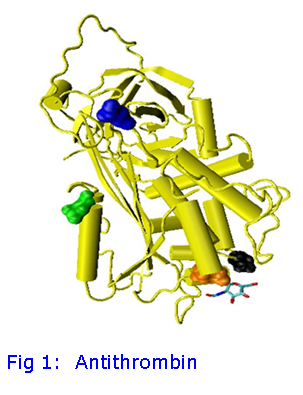Development Of A Novel, Rapid Assay For Detection Of Heparin-Binding Defect Antithrombin Deficiencies: The Heparin-Antithrombin Binding (HAB) Ratio
Clinical relevance
Antithrombin (AT) is a natural anticoagulant, a substance that regulates blood clotting. AT deficiency is a blood disorder that may be inherited or acquired. The deficiency can be caused by reduced production of a normally functioning protein (Type I), a quantitative deficiency or a qualitative deficiency (Type II) where there are normal amounts of AT but it is not fully functional. Type II deficiencies affect either the reactive site (RS), which binds to the molecules that AT ‘switches off’, or the heparin-binding site, which permits molecules such as the therapeutic anticoagulant drug heparin to increase the ability of AT to regulate clotting.
Patients with inherited AT deficiency have an increased risk of developing a deep vein thrombosis or pulmonary embolism. In patients with acquired AT deficiency the risk of developing blood clots is not always increased and is the consequence of some other disorder, usually involving the liver, kidneys or treatment of certain types of blood disorders e.g. leukaemia. In these patients the disorder may be reversible with treatment.
Patients heterozygous for type II heparin-binding-defect (HBD) mutations have a much lower prevalence of thrombotic events compared to those heterozygous for types I, II RS and II PE (pleiotropic effect, which can affect both binding sites). Nonetheless, their identification is relevant in patients who do experience clinical events, where co-inheritance with another thrombophilia occurs or where standard doses of heparin do not achieve therapeutic APTT values due to loss of its accelerating effect. APTT is a test that monitors heparin therapy. Numerous commercial assays with similar analytical properties and design are available for measuring AT activity. Such assays readily identify quantitative deficiencies and most dysfunctional variants that cause Type II RS, but prolonged incubation with heparin in the assay design can overestimate the AT level in the presence of Type II HBD, especially in heterozygotes.
Assessment of the new methodology
Viapath’s Haemostasis & Thrombosis Department has developed a novel modification of readily available AT assays that quantifies heparin-binding capacity of AT by deriving a ratio of AT activities generated from short and prolonged incubation times with heparin. A reduced Heparin-AT binding (HAB) ratio should be realized in most patients with AT deficiency due to HBD but not in those with Type I deficiency, Type II RS or individuals with no AT defects. Plasmas from genetically proven HBD patients and normal donors were assayed for AT activity by Factor Xa-inhibition and thrombin-inhibition at varying incubation times to optimise assay conditions for generation of the HAB ratio. Fourteen patients with hereditary AT deficiency, including five with HBDs, were analysed using the FXa-inhibition and nine patients with hereditary AT deficiency, including three with HBDs, were analysed using the thrombin-inhibition assay.
Results of the evaluation
The FXa-inhibition assay in two genetically confirmed HBD patients with prolonged heparin incubations clearly produced HAB ratios of 0.67 and 0.24 respectively (reference range 0.90 – 1.01). However, three plasmas containing mutations with markedly reduced or absent heparin affinity gave normal results. Nine AT deficient plasmas were tested with the thrombin-inhibition assay and all generated reduced HAB ratios whilst two normal donors did not. The three available HBD plasmas generated lower values than non-HBD plasmas. The mildly reduced HAB ratios in non-HBD deficiencies may have been due to heparin cofactor II reacting with bovine thrombin during extended incubation.
Click here to view the results
Conclusions: HAB ratio from FXa-inhibition assays distinguishes some but not all HBD from non-HBD ATs, and thrombin-inhibition assays may be diagnostically applicable with sub-type specific cut-offs.
Practicalities
This assay is performed at Viapath’s Diagnostic Haemostasis and Thrombosis Laboratory: 4th Floor North Wing St Thomas’ Hospital, Westminster Bridge Road, London SE1 7EH.
The turnaround time is: 7-12 days.
For more information about the detection of heparin-binding defect antithrombin deficiencies, please contact:
Dr Gary W. Moore, Consultant Biomedical Scientist, Head of Diagnostic Haemostasis
Email: gary.moore [at] viapath.co.uk
Naomi de Jager, Senior Biomedical Scientist
Email: naomi.dejager [at] viapath.co.uk
Jacqueline A. Cutler, Operations Manager, Haemostasis and Thrombosis
Email: jacqueline.cutler [at] viapath.co.uk
For more information about detection of heparin-binding defect antithrombin deficiencies, please refer to the recent article or contact Dr Moore for a copy:
Moore GW, de Jager N, Cutler JA. Development of a novel, rapid assay for detection of heparin-binding defect antithrombin deficiencies: the heparin- antithrombin binding (HAB) ratio. Thrombosis Research 2015;135:161-166
Other Publications Relating to Antithrombin Deficiencies
Posters:
MJ.Mitchell, JA.Cutler, R. Wheeler, J. Alamelu. Four young children with thrombotic complications as a result of antithrombin heparin binding defects. ISTH 2015
N de Jager, JA Cutler, GW Moore. Development of a novel, rapid assay for detection of heparin-binding defect antithrombin deficiencies: the heparin-antithrombin binding (HAB) ratio. Sysmex UK User Symposium 2016.
Publications:
Brown SA, Mitchell MJ, Cutler JA, Moore GW, Smith MP, Savidge GF. Rapid genetic diagnosis in neonatal pulmonary artery thrombosis caused by homozygous Antithrombin Budapest 3. Clinical Applied Thrombosis/Haemostasis 2000; 6: 181-183
Bramham K, Retter A, Robinson SE, Mitchell M, Moore GW, Hunt BJ. How I treat heterozygous hereditary antithrombin deficiency in pregnancy. Thrombosis & Haemostasis 2013:110:550-559
Moore GW, Jennings I. Thrombophilia. In: Moore GW, Knight G, Blann AD. Fundamentals of Biomedical Science. Haematology. Oxford University Press, UK: First edition 2010; Second edition 2016

